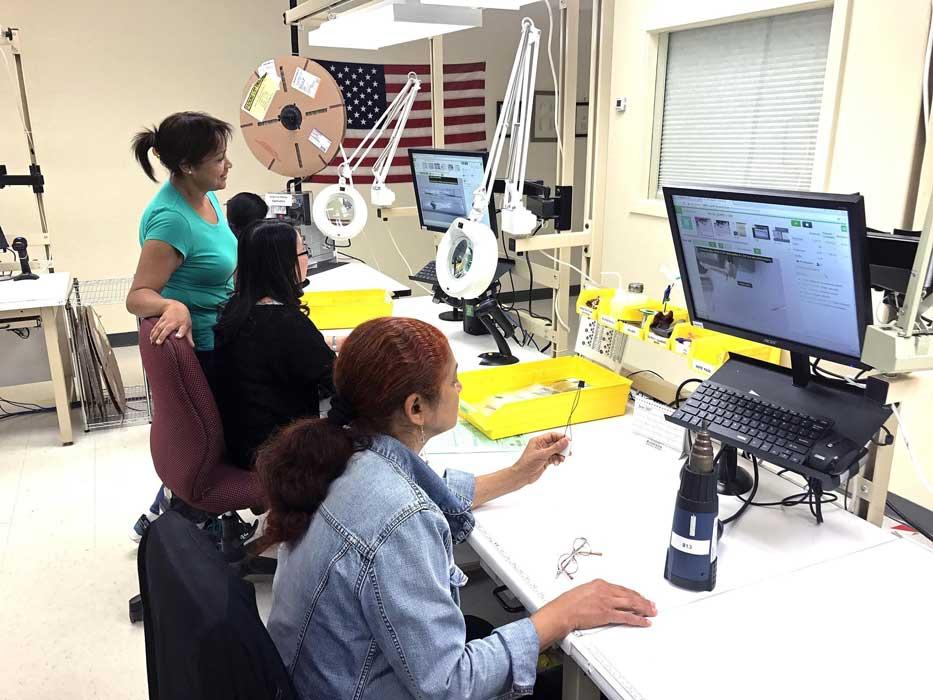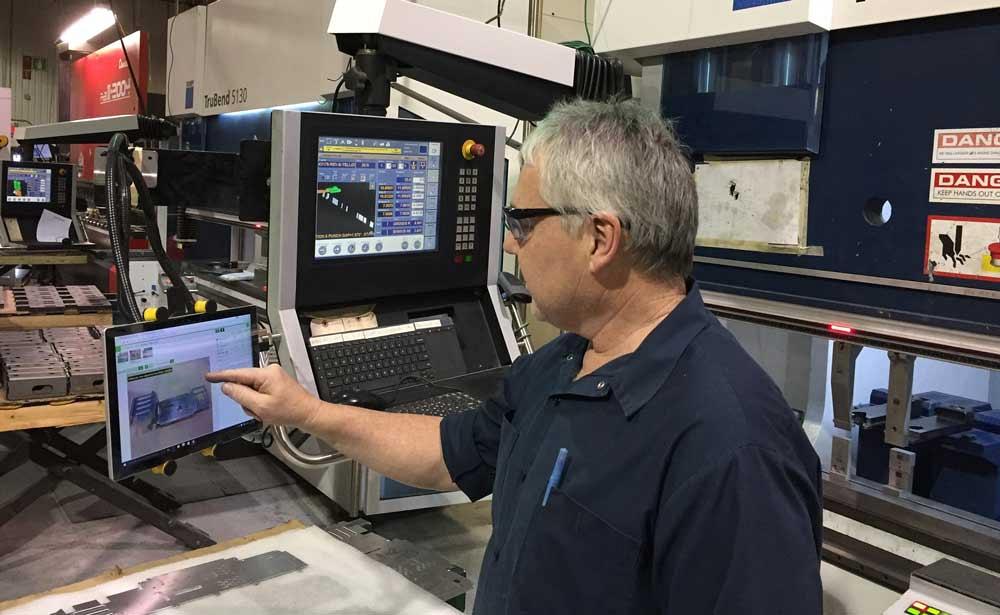- FMA
- The Fabricator
- FABTECH
- Canadian Metalworking
Categories
- Additive Manufacturing
- Aluminum Welding
- Arc Welding
- Assembly and Joining
- Automation and Robotics
- Bending and Forming
- Consumables
- Cutting and Weld Prep
- Electric Vehicles
- En Español
- Finishing
- Hydroforming
- Laser Cutting
- Laser Welding
- Machining
- Manufacturing Software
- Materials Handling
- Metals/Materials
- Oxyfuel Cutting
- Plasma Cutting
- Power Tools
- Punching and Other Holemaking
- Roll Forming
- Safety
- Sawing
- Shearing
- Shop Management
- Testing and Measuring
- Tube and Pipe Fabrication
- Tube and Pipe Production
- Waterjet Cutting
Industry Directory
Webcasts
Podcasts
FAB 40
Advertise
Subscribe
Account Login
Search
Industry 4.0 is alive and well
The new industrial revolution is alive and well
- By Simon Spencer
- October 23, 2017
- Article
- Shop Management
With any industrial revolution, technology emerges to change manufacturing. The current revolution is no different.
The Industrial Revolution, which everyone learns about in history classes, paved the way for the beginning of the factory system. New iron production processes were introduced, and manufacturers transitioned from manual production methods to water- and steam-powered processes. The second industrial revolution saw a new wave of modernization with the advent of electric-powered systems that helped to fuel the growth of mass production assembly lines. The third industrial revolution pushed companies into the computer age with robotics and automation.
All of these revolutions resulted in new levels of manufacturing productivity. Manufacturing companies learned to make things faster, more efficiently, and more cost-effectively. They also achieved new levels of efficiency with their raw material supply chains and their distribution networks.
So what’s the fourth industrial revolution have in store for manufacturers? Believe it or not, you are probably already doing it, but not totally aware of it.
Industry 4.0 is about connecting everything together. Machines are connected to each other. Sensors feed manufacturing data to software systems. Software accumulates that data and delivers real-time analytics to managers, who can access the information on a laptop, tablet, or even a phone. You can make decisions based on live data from your entire factory network.
Of course, these developments will further improve manufacturing efficiencies and maximize profits for companies that are able to attain these new levels of information exchange. But it is noteworthy that manufacturing needs didn’t drive this latest iteration of revolution. Industry 4.0 was running a little late.
This industrial revolution is about connectivity. Where have you heard about that before? Just look at the internet:
- Google, founded in 1998, has emerged as the world leader in web-based services, connecting people’s questions with a seemingly infinite supply of answers.
- LinkedIn, founded in 2002, is a huge business and employment social networking service, connecting employees in the working world with each other and possibly future employers.
- Facebook, founded in 2004, is the world’s premier social networking service, connecting us with one another and with our favorite interests.
- Twitter, founded in 2006, started as a microblogging site and now occupies a position as one of the leading tools to disseminate news, directly connecting the newsmakers with their information-starved public.
Whether you use these applications or not, they represent the beginning of the interconnected world. We are to the point where we don’t ask each other a question; we go directly to an audio-enabled interface connected to the web.
Industrial revolutions, from a social point of view, always hold the potential to scare the masses. You have instability as companies try to adopt these disruptive technologies. Underskilled people find themselves obsolete as certain roles are automated, so unemployment rates increase.
But in this revolution, interconnectivity promises to push manufacturing forward, just as social media has elevated the exchange of ideas and democratized access to information. As past revolutions have resulted in positive outcomes, such as dramatic drops in mortality rates and substantial increases in life expectancy, this revolution promises to boost manufacturing efficiencies to new highs never before achieved.
Industry 4.0 empowers the employee in such a way that the individual is at the hub of progress. This isn’t about the CEO collecting data, monitoring the results, and making the right long-term plans. It’s about the worker on the shop floor doing things in a manner and in an expedited time frame that his or her counterpart from just 10 to 15 years ago couldn’t accomplish.
The following are a few different cases that illustrate how Industry 4.0 is alive in today’s diverse manufacturing and fabrication environments.
Case No. 1: Going Visual for Assembly Work
Assembling products requires a high level of manual intervention. Because of this, companies tend to struggle in terms of being productive and maintaining quality. In some instances, the effort is exacerbated for those manufacturers that rely on temporary employees that may not stick around long enough to learn certain processes. It is for this reason that detailed work instructions are critical for operators to achieve success.
Several manufacturing companies rely on paper-based instructions. They are OK at best, but are hard to read. The emergence of web-based work instructions that can be delivered to monitors or tablets has changed all of that (see Figure 1). The information is delivered in real time and is easy to understand. Operators can see information while they are working in a visual, intuitive way, much like a driver who can rely on global positioning satellite technology instead of maps. The impact and benefit derived from this type of interface have helped manufacturers achieve new levels of operational excellence that simply couldn’t be done with paper-based instructions.
Case No. 2: Updated Fabrication and Documentation
Paper everywhere and none of it is updated! Many companies suffer from not having the latest information at hand. The problem leads to wrong setups, bad parts, costly rework, and annoyed customers.
Industry 4.0 solves this problem perfectly because paper becomes a thing of the past (see Figure 2).
Each work order can be linked to the latest revisions documentation, whether that is drawings, CAD models, machine setup guides, or customer specifications. The most up-to-date documentation required for a job is only a click away on a digital device.
Case No. 3: Connecting With Machines and Tools
Say your company fabricates a part that is critical to the safe operation of an end product. It’s critical that the part meets 100 percent of the customer’s specifications. Guaranteeing that part quality is labor-intensive, with checks, double-checks, and triple-checks. The liability of failure is horrendous, so it needs to be correct.
Again, Industry 4.0 is here to solve that problem as well. Companies invest thousands of dollars in tools and equipment that can measure and validate every step of an operation. Now those tools can connect directly with work instructions and prevent the progression of activities until the exact expected result is achieved (see Figure 3). Industry 4.0 can now force the fabricator to do it right the first time. Additionally, each and every action is recorded and can be produced as evidence of adherence to processes.
Industry 4.0 Results
Imagine your shop floor full of employees contributing at high levels because Industry 4.0 is empowering them. They have access to best practices in the form of pictures and video for each job they carry out.
They can share productivity ideas or safe work practices across a facility or the globe instantly.
Instead of having a second pair of eyes validating activities, your tools and equipment can instantly report problems or nonconformance situations.
Your employees know they have done a good job; they also know when something has gone wrong, and they have the ability to fix it immediately.
Industry 4.0 augments each and every human being with the knowledge and capability to do things right and to make improvements. Rapidly and visually sharing knowledge is the new key to success.
For more information on this subject, please visit vksapp.com.About the Author
subscribe now

The Fabricator is North America's leading magazine for the metal forming and fabricating industry. The magazine delivers the news, technical articles, and case histories that enable fabricators to do their jobs more efficiently. The Fabricator has served the industry since 1970.
start your free subscription- Stay connected from anywhere

Easily access valuable industry resources now with full access to the digital edition of The Fabricator.

Easily access valuable industry resources now with full access to the digital edition of The Welder.

Easily access valuable industry resources now with full access to the digital edition of The Tube and Pipe Journal.
- Podcasting
- Podcast:
- The Fabricator Podcast
- Published:
- 04/16/2024
- Running Time:
- 63:29
In this episode of The Fabricator Podcast, Caleb Chamberlain, co-founder and CEO of OSH Cut, discusses his company’s...
- Industry Events
16th Annual Safety Conference
- April 30 - May 1, 2024
- Elgin,
Pipe and Tube Conference
- May 21 - 22, 2024
- Omaha, NE
World-Class Roll Forming Workshop
- June 5 - 6, 2024
- Louisville, KY
Advanced Laser Application Workshop
- June 25 - 27, 2024
- Novi, MI


































